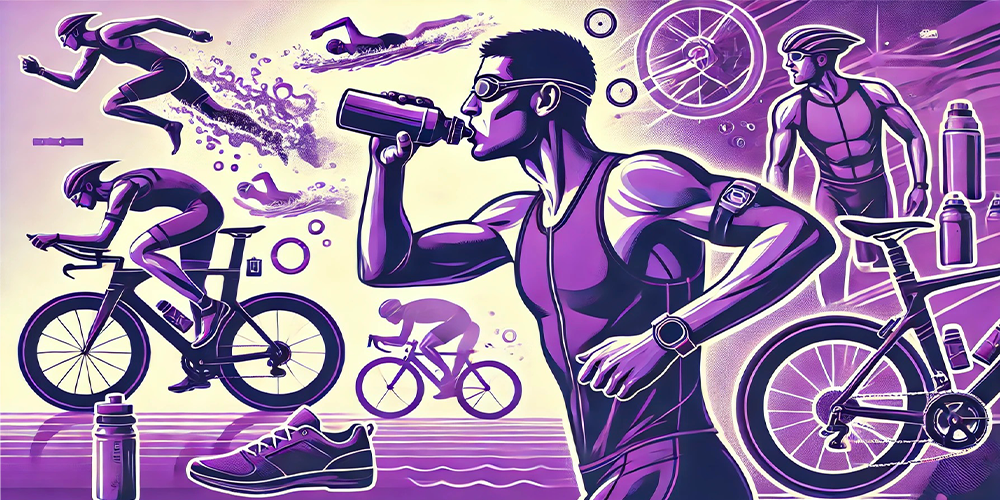Triathlon is a competitive sport and it’s during competitions that you can truly experience the unique sensations offered by transitions. Of course, you can replicate this in training, but it’s not quite the same as when you’re wearing a race bib. Successfully completing your race on the big day depends on specific preparation beforehand, both technically, physically, and mentally. However, even with thorough preparation, there is one aspect that can undermine all your goals: nutrition!
Article published in TrimaX-magazine n°218– July 2022 Author: Jean-Baptiste Wiroth
This article was provided to us by Trimax Magazine, one of the leading triathlon magazines. A new edition is published every month, featuring articles, profiles, race tips, equipment advice, and much more. To discover all the latest news in triathlon, cycling, running, duathlon, and swimrun for free, click here.
Goals of Race Nutrition
The primary goal is to delay the onset of fatigue during the triathlon. Indeed, in addition to adequate physical preparation, nutrition plays a fundamental role in preventing the phenomenon of early fatigue.
The other goals of competition nutrition are to:
- Prevent digestive issues
- Facilitate post-exercise recovery
In short-distance triathlons (efforts of less than 2 hours), nutrition plays an important, but not crucial role. In these races, it’s more about avoiding certain mistakes that could compromise the final result (like having a meal that’s too heavy or too late).
On the other hand, long-distance triathlons represent the pinnacle of difficulty in terms of energy and metabolic demands. The significant energy expenditure induced by long hours of effort necessitates adopting a suitable nutritional strategy to finish your race “cleanly.”
Main Mistakes to Avoid
- Eating your last meal too late… and finding yourself in the middle of digestion during the swim. The last meal should be light and digestible to avoid any significant digestive effort.
- Trying a new sports drink on race day… and discovering that it’s nauseating. It’s essential to always test new supplements (drinks, bars, gels…) or foods in training to ensure they are well-tolerated.
- Drinking only plain water… and finding out that it’s not enough in terms of energy and mineral intake. Of course, the foundation of competition nutrition is maintaining proper hydration. In this regard, slightly salted water is ideal for quickly transporting fluids from the digestive tract to the bloodstream.
- Consuming too many fibers in the days leading up to the race… and experiencing digestive problems on race day. While fibers are essential for proper digestive function, they can overload or irritate the intestines and colon on race day. It’s advisable to reduce fiber intake 3 to 5 days before the competition.
- Overeating on the bike… and ending up in full digestion mode during the run. Although rare, it can happen.
Special Case of Long-Distance Triathlons
Long-distance events are characterized by durations generally ranging from 5 to 15 hours and moderate intensity (70% of maximum aerobic power). At this pace, the muscles use an energy mix composed of about half glucose and half fatty acids. Since the body’s glycogen stores are limited (300 to 500 g in muscles and liver, depending on body size), proper effort management involves regularly supplying muscles with carbohydrates to optimize the use of exogenous carbs (absorbed during the effort) and reduce the oxidation of endogenous carbs (stored in muscles and liver as glycogen).
Before the Effort
The number one rule is to maintain your (good) eating habits while making some adjustments to ensure optimal glycogen storage and start the race well-hydrated.
Experts currently agree that it’s not necessary to overconsume carbs to effectively store glycogen. In the 3 days before the race, increase the portion of starchy foods (pasta, rice, semolina, potatoes…) consumed at each meal by 25%, while maintaining a balanced nutritional profile (65% carbs / 20% fats / 15% proteins).
Those who are sensitive at the digestive level should limit their intake of fruits and vegetables to avoid overloading the digestive tract. However, it’s important to note that plant fibers can retain absorbed liquids by swelling with water, which can be particularly useful in a hot race. This should be tested before the event!
The last meal should be easy to digest to avoid excessive digestive effort and prevent discomfort at the beginning of the race (vomiting). The time between the end of the meal and the start of the warm-up should generally be between 1h30 and 3h.
A course of branched-chain amino acids (leucine, isoleucine, valine) can be beneficial as they contribute to energy supply in the final part of the race and limit the increase in brain serotonin levels (probably responsible for cognitive and neuromuscular fatigue during prolonged efforts).
During the Effort
During a long-distance triathlon, the primary nutritional goal is to delay the onset of fatigue (muscular, nervous, and psychological). To achieve this, the nutritional requirements are to:
- Limit dehydration
- Prevent hypoglycemia
- Provide energy to the muscles
- Prevent digestive issues
- Avoid nausea caused by overconsumption of overly sweet products
To effectively meet these requirements, it is highly recommended to use a sports food composed almost exclusively of carbohydrates. Sports nutrition experts currently agree that the ideal food should contain a mix of carbohydrates (glucose, fructose, and maltodextrins). This mix allows for a higher muscle oxidation rate (around 1.5-1.7 g/min) than if you consume one of the three types of carbohydrates alone (around 1 g/min). This difference is due to specific transporters that allow glucose, fructose, and maltodextrins to pass through the digestive membrane independently.
So far, the ideal mix (if it exists) has not yet been determined. However, it’s believed that a 20% glucose / 20% fructose / 60% maltodextrin ratio is a good compromise for long-distance triathlons (from half to Ironman). Such a mix will be absorbed quickly without causing a digestive “blockage,” while ensuring energy supply and optimal hydration.
Sports nutrition, whether liquid or solid, should provide 50 to 80 g of carbohydrates per hour of racing. Such levels of energy intake require specific training of the digestive tract (which can be trained like muscles or any other organ).
Example of a nutritional strategy for long-distance events like Ironman in hot conditions:
- Swim: 250 ml of energy drink just before the start or 1 gel (40-50g) + 250 ml of water
- Swim/bike transition: 1 energy gel (40g) + 250ml water
- Bike: The goal is to drink 500 to 750 ml of drink per hour of racing, about 100 ml of energy drink every 10 minutes. Every hour, take a fruit (banana), an energy bar, or a gel with water. For those who quickly tire of the sweet taste, using a salty or neutral drink can be particularly beneficial (e.g., maltodextrins with a neutral taste).
- Bike/run transition: 1 energy gel (25g) + 250 ml water
- Run: in theory, you should maintain the same hydration frequency using a hypotonic (lightly concentrated) energy drink. Every 30 minutes, take 1 fruit or an energy gel with water.
Some Notes
Branched-chain amino acids (BCAA): the addition of proteins or amino acids does not seem to improve performance according to scientific literature. However, for efforts longer than 10 hours, consuming a small portion of BCAA on the bike is not prohibited.
Caffeine (read our article in issue n°215): Numerous studies have shown that ingesting caffeine before and during exercise helps delay fatigue. Various mechanisms have been proposed to explain this phenomenon:
- Improved glucose absorption. By acting on the intestinal mucosa, caffeine could help absorb more exogenous glucose during exercise.
- Decreased neuromuscular fatigue, which eventually occurs during endurance efforts. The physiological phenomenon would occur at the junction between motoneurons and muscle fibers. Caffeine’s positive action could increase the time limit at a given power or running speed.
- Insulin resistance. Caffeine could induce insulin resistance, thereby limiting blood sugar fluctuations during low-intensity phases of exercise (e.g., long downhill rides).
- Improved alertness. It’s strongly suggested that caffeine allows for better concentration and more effective information processing.
- Altered perception of effort. After ingesting caffeine, it seems that the effort is perceived as less difficult.
Glossary
Glycemic index (read our article in issue n°197): Some athletes show a form of intolerance to fast sugars, making them prone to blood sugar variations during exercise. Hyperinsulinism is often the cause of this problem. In such cases, do not hesitate to resort to much simpler foods (water, fruits, small ham sandwiches…) to avoid energy slumps.
Sodium: To facilitate gastric emptying, the ideal energy drink must contain sodium in small quantities (add 1g of sodium chloride per bottle). The use of salt tablets is not really recommended. If you are prone to exercise-induced cramps, you can still test salt tablets during training.
Solid food: Consuming solid food is often necessary to avoid the onset of hunger and vary your diet. To limit digestive problems, it is highly recommended to consume solid food at the beginning of the bike segment and drink water (not energy drinks) alongside it. To facilitate digestion, avoid consuming solid foods that are too fatty or high in protein.
Digestive issues: It is recommended to undertake real nutritional training to prevent digestive issues. Therefore, use in training the same foods you plan to consume on race day, and avoid eating unfamiliar foods during the race. Avoid ice-cold drinks. We will cover this topic in more detail in a future article.
References
- Jeukendrup et al. Oxidation of carbohydrates feedings during prolonged exercise. Sports Med. 2000 Jun; 29 (6): 407-424.
- Tsintzas et al. Human muscle glycogen metabolism during exercise. Sports Med. 1998 Jan; 25 (1): 7-23.



